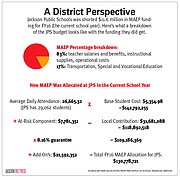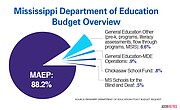Wednesday, October 21, 2015
The Mississippi Adequate Education Program is the state's formula to "establish adequate current operation funding levels" in each school district under the Mississippi Department of Education's jurisdiction to meet a "successful level of student performance." MAEP funding (theoretically) covers teacher and district employee salaries, retirement and insurance, instruction materials, operational costs, transportation, and special, vocational, gifted and alternative education. MAEP accounts for the majority of the Department of Education's budget, funded by the Legislature and Mississippians' state tax dollars. Mississippians will vote on Nov. 3 on Initiative 42, designed to force the state Legilsature to fully fund MAEP.
Key Terms:
Average Daily Attendance:*
Calculated in the second and third month of preceding year for school districts of all students K-12 (excludes self-contained special education, and accounts for consistent growth of district over 3 years).
Base Student Cost:
Calculated by averaging components of "successful and efficient" schools and districts. The components averaged are Instruction (teachers per 1,000 students), Administration (admin/staff ratio), Maintenance and Operations (spending per 100,000 square feet, maintenance staff per 100,000 square feet) and Ancillary (librarians and counselors per 1,000 students). The base student cost is re-calculated every four years, and an inflation adjustment is made in off-years.
At-Risk Component*:
The at-risk component number is 5% of the base student cost multiplied by the district's number of free-lunch participants on Oct. 31 of the preceding year.
Local Contribution*:
Using the second preceding year's data, property value taxes and yield from mills based on local tax base is collected and capped at 27% of the program costs.
8% Guarantee*:
This is the catch-all if after the above components are calculated, a district still doesn't receive at least 8 percent more funding than they did 13 years ago (in 2002), they will get at least that much funding.
Add-On Programs*:
These funds go toward Transportation, Special Education, Gifted Education, Vocational Education, Alternative Education
Transportation: Amount of funding for transportation in each school district is based on the Average Daily Attendance of students who take school district transportation—there is a set cost per student set by the State Board of Education rate table. The rate table divides the students who use district transport by the total square miles in the district.
Special and Gifted Education: A teacher unit is added for each approved program in district—funding is based on certification and experience of approved teacher, and approved through calculation in four specific MDE offices.
Vocational Education: Half of a teacher unit is added for each approved program in district—funding is based on certification and experience of approved teacher, and approved through calculation in four specific MDE offices.
Alternative School Programs: .75% of the district's Average Daily Attendance or 12 students, whichever is greater, is multiplied by the state average per pupil expenditure in public funds for the preceding school year.
*value dependent on school district size, numbers or Average Daily Attendance (The Base Student Cost stays the same across all districts)
School Funding Myths and Realities
- Myth: "In over 55% of local school districts, in the last year of full recalculation, the formula did not calculate enough in the instructional cost component to cover the costs of salaries and benefits for classroom teachers." - Sept. 2015 State Auditor MAEP Report
- Reality: The Legislature underfunded MAEP by $201 million last year—and whether or not the formula is working or not needs to be in the context of "adequate and efficient." This formula was designed with the least possible funding in mind—"excellent and above average" education likely requires more funding than theMAEP budget asks for.
- Myth: Initiative 42 will transfer education funding power and policy-making to a single judge in Hinds County. - 42truth.com; anti-42 Campaign
- Reality: No legal action will be necessary to enforce Initiative 42 if it passes if the Legislature follows the law. If a lawsuit is brought against the Legislature, the legal process begins in Hinds County because that's where the Legislature is located, but any case could be appealed to the Mississippi Supreme Court, who would have the final say—not a judge in Hinds County.
- Myth: If Initiative 42 passes, the Legislature will be forced to fully fund MAEP immediately. - GOP leaders via Rep. Herb Frierson, House Appropriations Chairman
- Reality: The Legislature will be forced to fully fund MAEP if Initiative 42 passes, but timing was considered in the original ballot initiative. The initiative suggests a phase-in approach to funding MAEP using 25 percent of the general fund increases with a target date as far away as FY2022.
School Funding Pros and Cons
- Pro: "Just like any policy you put in place, you have to continue to work with it so it's meeting the needs of citizens. The idea of something being 'bad policy' is subjective based upon approach." - Corey Wiggins, Hope Institute Policy Center
- Con: Initiative 42 is "bad policy." - Sid Salter in the Clarion-Ledger, top GOP leaders
- Pro: "The bottom line is, the formula does a very good and inexpensive job of getting us to the point where school districts agree that it gives them enough money—the cost of this is so little, it's a bargain. The fact that we're arguing about this shows how far off base we are." - Sen. Hob Bryan D-Amory
- Con: "Voting in favor of Initiative 42 will force the Legislature to fully fund MAEP immediately and will cause necessary 7.8% budget cuts from all other state departments." - Rep. Herb Frierson, House Appropriations Chairman
- Pro: "The auditor's report is not a serious effort to deal with the dilemma—if you look at all the complaints about the formula over the years, they come from people who don't believe in it." - Sen. Hob Bryan D-Amory, one of the original authors of MAEP in 1997
- Con: "The MAEP formula absolutely does not distribute funds according to educational need." - September 2015 State Auditor MAEP Report
PACman: Follow the Initiative 42 Money
Here's a quick guide to who's who in the money race to squash or push the citizen-driven initiative on the ballot in November. The amounts listed were raised by early October. The next filing date is Oct. 27.
Pro-42 Camp:
PACs:
Better Schools, Better Jobs
Amount Raised: $1.65 million
Cash on Hand (Oct. 9 filing): $78,286
Funders: Jim Barksdale, Dick Molpus, Kellogg Foundation (an AP report found these three funders gave money to the out-of-state funders who donated to Better Schools, Better Jobs)
Out-of-State Funders: Southern Education Foundation, New Venture Fund
Anti-42 or 42A Camp:
PACs:
Improve Mississippi PIC
Amount Raised: $200,100
Cash on Hand (Oct. 9 filing): $199,950
KidsFirst PAC
Amount Raised: $123,800
Cash on Hand (Oct. 9 filing): $110,285
Top Politician Funders: Gov. Phil Bryant, Lt. Gov. Tate Reeves, House Speaker Philip Gunn, House Appropriations Committee Chairman Herb Frierson
Out of State Funders: Americans for Prosperity (KidsFirst)


